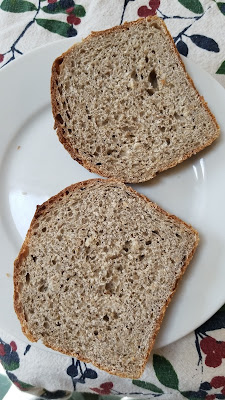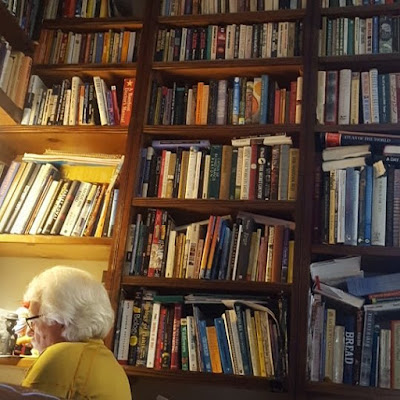So this is my go to bread.
First, I work in grams and baker's percentages, and for those of you who do not know how that works let me explain it. Don't worry, I also have the recipe in cups, but that is so less precise and often the reason why things fail. You need to buy a scale that works in grams if you want to be a serious bread baker; they are cheap (mine was $16 and is good enough).
How do bakers percentages work? Solids like flour and oats (in this recipe) together are always 100%. Some bakers just say let's start with 1000 grams, but sorry, as you will see, this recipe starts with 1020 grams. The liquid you add makes the baker's percentage. You add water (sometimes milk, beer or cider) and the ideal is about 70% to 80%. If you want a baker's percentage of 70% you would add 700 grams of liquid to 1000 gram flour (solids). Less liquid (60%) makes to bread denser and heavier more liquid makes it softer and more open. High moisture breads, 80% or higher makes foucaccia.
In the recipe below you have 1020 grams solids and 760 grams water which give you a baker's percentage of 760/1020=75% (whole wheat and oats are thirstier than only white flour).
This recipe uses oats. I sometimes use Bob's Red Mill 10 grain cereal instead, or cracked rye, a mix of the two, or of all, just keep it to the 120 grams. The other day I actually put in 120 grams of baked sweet potato, this made a very nice tasting bread, especially when toasted. There is a lot of moisture in a baked sweet potato so you could reduce the water a little (say by maybe 10 or 20 grams; just experiment) or add a little flower (not too much).
As I mentioned, I will leave the cups in the recipe, but I found it not accurate enough, and it gives you not enough dough to sufficiently fill two 9 inch bread pans. In the grams recipe I have increased everything by approximately 20% to get a nice loaf for our standard U.S. 9 inch pans.
Bakes 2 loaves (again, the grams recipe is more accurate and is 20% more than the cups recipe)
- 1 cup oats ... 120 grams
- 2 cups of boiling water ... 760 grams
- 1 Tablespoon molasses or honey ... 2 Tablespoons for the grams recipe (lately I have not been using any honey or sweetener)
- 2 teaspoons salt ... 8 grams
- 1 cup whole wheat and 4 1/2 cups bread flour (all-purpose flour is ok too) … 900 grams (300 whole wheat and 600 bread flour)
- 1/2 Tablespoon instant yeast (I only use instant or bread machine yeast, which does not need blooming)
- 1 Tablespoon butter or oil, plus more for the pan … 2 Tablespoons (I use coconut oil, but lately I do not use oil at all. Fat makes the bread softer; just do not use an oil with a strong flavor like olive oil)
1. Place the oats in a large bowl. Bring water to a boil and pour 200 grams over the oats. Stir in the sweetener and butter if you are using it. Let stand and cool for 20+ minutes (make sure it is cools to 110 to 100 degrees). When it reaches that temperature stir in the yeast.
2. While the oats mixture is cooling mix the flour with the remaining cool water. Mix and knead just enough to incorporate all the flour and water together. Let the mixture rest (covered) for 15 to 30 minutes.
2. While the oats mixture is cooling mix the flour with the remaining cool water. Mix and knead just enough to incorporate all the flour and water together. Let the mixture rest (covered) for 15 to 30 minutes.
3. Mix the oat mixture into the rested dough and add the salt. Knead in the bowl until a shaggy dough comes together, then pull out onto a floured work surface and knead, adding more flour as needed, until the dough is no longer sticky and relatively smooth (the oats won't make it completely smooth), about 15 minutes. Resist adding more flour in the beginning, it will start out very sticky, but after 10 or so minutes it should get less and less sticky.
4. Shape the dough into a ball, place back in the mixing bowl, cover with a dish cloth and place in a warm, draft-free spot (like a turned-off oven) to double in bulk (about an hour).
5. Butter two standard loaf pans (I use Pam or some other cooking spray). When the dough has doubled in bulk, gently pull it out of the bowl onto the work surface. Carefully cut the ball in half. Do not knead, but gently fold and shape the ball into a loaf shape the length of the loaf pans. Place each piece of dough into a pan, cover anew with the dish cloth and let rise until doubled in bulk (about an hour).
4. Remove from the oven, if that is where you were letting the loaves rise, and preheat to 425. Approximately 5 minutes before the loaves go into the oven place a roasting pan on the bottom rack in the oven with some water in it to create steam. Remove the dish cloth and place the pans in the oven. I score the loaves with a sharp knife. When putting the pans in the oven watch out for the blast of steam! Bake for 20 minutes with the steam. After the 20 minutes remove the baking pan with the water (watch out for the blast of the steam) and continue baking for another 25 minutes. Cool on a wire rack and enjoy, The bread will keep in a bread box for 4 to 5 days or can be frozen in plastic freezer bags.
About kneading:
I love kneading, it is very meditative. But there is also folding and I am really starting to like that technique. This involves a quick knead in the bowl in the beginning to get everything incorporated and then letting the dough rest. After a half hour you grab the dough (with wet hands) at one side and you pull it over itself (without tearing the dough) and you go around on all sides for a few times. You then rest the dough for a half hour and repeat. You do this three or four times and then you rise it for an hour and pan it. This method it often done with sour dough and if you do it with yeast (as I do it with this recipe) I half the amount of yeast, which makes the first rise (or proofing) go much slower (approximately 2.5 to 3 hours). Some books say let it double others say triple the size. YouTube is full of demos on folding of dough and shaping of dough into loaves.
Bread making is fun and so much healthier. For me it has become flour, water, yeast. Nothing more and maybe just a little salt (yeast needs salt to function properly), no additives, nothing. Healthy, honest bread. At times, I may knead some sesame seeds, flax seeds or sunflower seeds with it. But only do that when shaping the loaves at the end. Enjoy!

